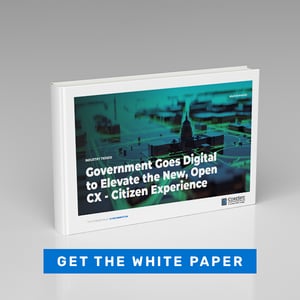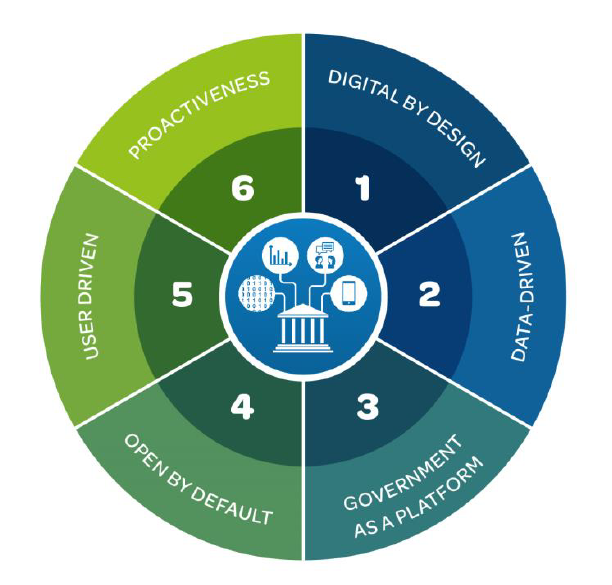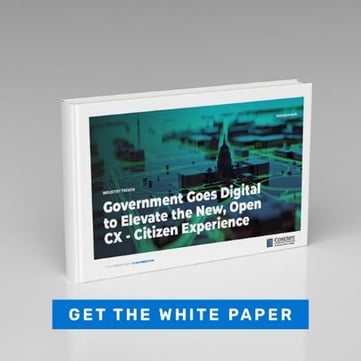
Digital Government Industry Trends Are All About Enhancing Customer Experience
Since the U.S. Digital Government Strategy was launched in 2012, digital transformation is full steam ahead. The objective is to elevate the customer experience – in this context “citizen experience” – which can make or break the success of digital government.

The Future of Government Digital Services
Agencies are focusing on citizen trust, transparency, accountability, inter-agency collaboration and partnerships, in addition to technology. Many agencies partner with colocation data centers to facilitate data sharing, digital service delivery, decision-making and other areas.
Let’s touch on three industry trends and reasons why colocation enables going digital with superior customer experience top of mind.
What will define government digital services? Three characteristics, according to the World Bank, are that services are contextual, coordinated and cognitive.1
- Contextual has to do with creating individualized, targeted service delivery with the use of digital tools that enable direct communication channels to citizens. For example, digital services are adaptive and tailored to each citizen’s circumstances.
- Coordinated refers to open, interoperable, sharable data made possible by application program interfaces (APIs) and access to diverse data repositories. For example, some countries are collaborating on public cloud infrastructure integration, 5G mobile technology and electronic health records (EHRs).
- Cognitive applies artificial intelligence (AI) and automation to assessing, understanding and responding to human behavior. For example, the U.S. Department of Veteran Affairs is exploring the use of Ellie, a virtual psychologist.
These characteristics are already woven into the digital government fabric, so we’ll see how they evolve going forward.
Trends to Consider as You Make Digital Government Decisions
Industry research helps make the case for budgets, priorities and implementation schedules as well as decisions about customer experience. These are a few of the trends worth watching:
Automation
Digital services depend on automation. Expect lots more of it in the future. According to Gartner, 75% of governments will have at least three enterprise-wide hyperautomation initiatives launched or underway in the next three years.2 How will this play out? Expect ever-greater use of artificial intelligence (AI), specifically artificial intelligence as a service (AIaaS), to enable agencies to fast-track AI-enabled tools like chatbots.
Cloud adoption
Compelling cloud benefits include scalability, operational continuity and resilience, and ready access to the latest data storage and computing services. Hybrid cloud and multicloud options enable governments to be “cloud smart,” enabling them to design and modernize IT solutions for customer access, managing sensitive data, compliance and more.
Cybersecurity
Security concerns rise with the skyrocketing number of connected devices, vulnerabilities introduced by remote access, third-party partnerships (such as as-a-service providers) and wireless infrastructures. To fight cybercrime, the federal government is making it easier to share threat information between public and private sectors; strengthening incident detection, investigation and remediation capabilities; and expanding multifactor authentication.
Colocation Enables Digital Services That Score High on Customer Experience
Federal, state and local agencies can capture significant value when they consolidate dispersed data centers into strategically located CoreSite colocation facilities. Consider the impact of simpler data center management, financial savings and the fast, reliable delivery of digital services through interconnection.
Using CoreSite’s native onramps to all major cloud providers, agencies can achieve up to 44% faster communications to cloud availability zones compared to the public internet,3 savings of up to 60% on cloud connectivity and roughly 70% for data replication.4
Additional advantages include:
- Application performance improvements driven by reliability and low latency
- Access to an ecosystem of cloud and IT service providers including federal system integrators, managed service providers, SaaS providers and network providers (carriers)
- Agility to adapt the infrastructure to changing needs of citizens, agencies and digital platforms

A Hybrid IT Strategy Accelerates Digital Government Outcomes
When you work with CoreSite experts, expect a collaborative approach that helps your agency be cloud smart and future ready. We’ll discuss trends, address technical challenges and help accelerate your digital transformation plans. Our customized colocation solutions and modern, compliant data centers offer 100% SLA-based uptime while helping you scale, reduce costs of operation and manage risk.










